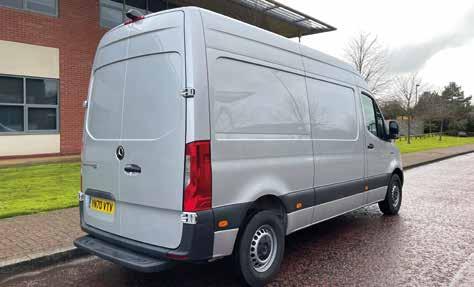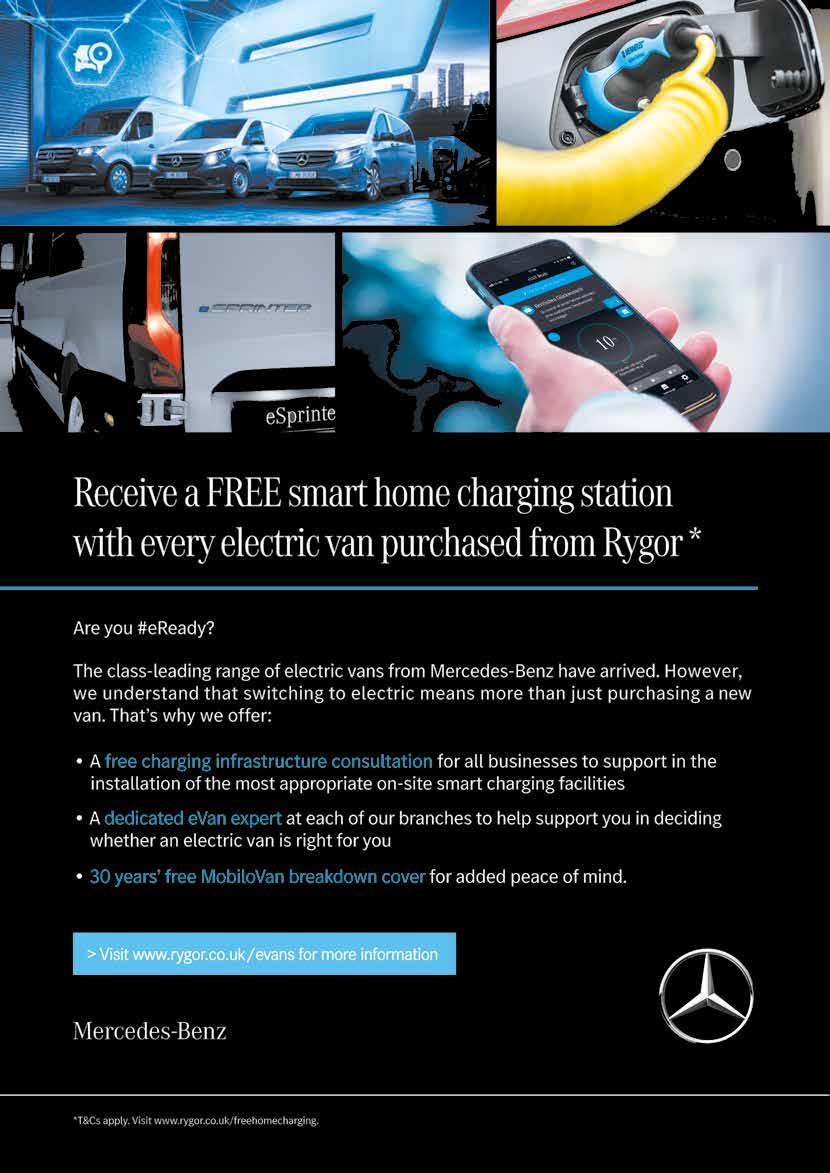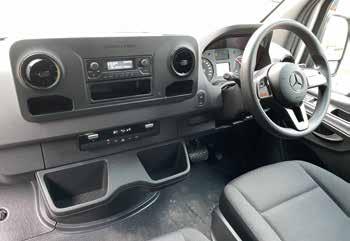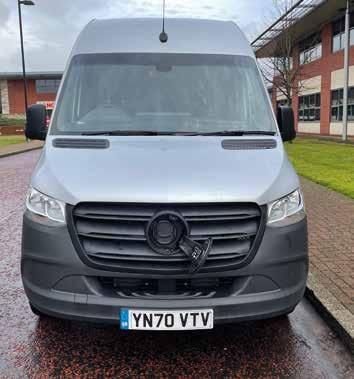
7 minute read
Mercedes-Benz eSprinter
eSprinter is the van for the discerning delivery driver
Mercedes-Benz’s eSprinter is the premium urban delivery vehicle but with a price tag north of 50k, does it offer value? Andrew Walker finds out.
Advertisement
We first drove the latest Mercedes-Benz Sprinter back in 2018 and came away mightily impressed. The brand stated then that an electric version would follow and in late 2020, Mercedes-Benz duly delivered, launching the eSprinter.
The eSprinter shares its running gear with the smaller eVito electric van, which we drove in 2020, and like its smaller electric brethren, it’s quite a bit more expensive than the diesel variant. Prices start from £51,950 for the eSprinter Progressive L2 H2 FWD, a price that excludes VAT and the OLEV grant. Customers should note that where the diesel range feature three specs – Pure, Progressive and Premium – eSprinter is only offered in Progressive trim and with one size of battery, the 55kWh. This equates to a range of up to 96 miles.
From the outside, there’s not a lot to distinguish the eSprinter from any other Sprinter. There’s a lower case blue ‘e’ in front of Sprinter on the rear left door, but that’s about it. Even the recharging port is tucked away, hidden underneath the Benz badge located in the centre of the front grille. Look inside and again, it’s almost identical to an auto diesel Sprinter, featuring the same steering wheel stalk gear lever, an identical dashboard and the same cabin storage. There’s also a top quality finish to the dash and the neat and tidy matt black interior.
The main difference is that underneath the Start button is a Drive Mode selector, which allows you to select from three electric driving modes, C, E and E+. C stands for Comfort and is the default mode, delivering the full power and torque of the van; E is for Economy and limits the power and torque; and E+ lowers the power further and also deactivates the climate control.
Furthermore, like many current EVs, eSprinter also comes with brake regeneration. You can adjust the level of this via steering wheel-mounted paddles. Default is D- which provides the most regen though you can also opt for D or D+, which both reduce the braking force. There’s also the option to choose D++, which turns the regen braking off.
All of these settings can be viewed in the instrument cluster located in front of the driver.
In Progressive spec, you get a heated seat for the driver with armrest, dual passenger seat, comfort overhead control panel, a full-width partition, height and rake adjustable steering wheel, TEMPMATIC air-con, a wooden floor, a mode 3 type 2 eight-meter charging cable, linear speed limiter 120km/h, headlight assistant, heat-insulating glass, and 270-degree double-wing rear-end doors. In addition to DAB radio, the Mercedes-Benz audio system comes with a Bluetooth interface with hands-free function and a USB port
Safety features include Active Brake ASSIST, Attention ASSIST, Crosswind ASSIST and Emergency eCall. There are also double locks and a Thatcham Category 1 approved alarm as standard, along with remote locking, theft warning alerts and geo-fencing, thanks to Mercedes PRO connect.
Standard charging speed is 20kW, which takes two hours to go from 10% to 80%. This can be upgraded to 80kW rapid-charging, which lowers that time to 30 minutes for the same increase in battery life. Both options come as standard with an eight-metre Type 2 cable. We would definitely recommend either of these charging methods as fully charging the eSprinter at home is time consuming, as we discovered. Using a 7.4kW Rolec home charger (https://www.rolecserv.com/homecharging) takes upwards of eight hours.
Continued on page 34



Continued from page 32
It’s worth knowing that Mercedes PRO connect is free for the first two years when you buy an eSprinter. It features a remote eCharging function, which enables drivers to programme cooling or heating while their van is still charging. Use this regularly and you will conserve battery energy while maximising driving range.
The power comes from four parallelmounted high-voltage battery blocks installed securely in the eSprinter’s underbody. They can be replaced individually in the event of damage. The clever location of these means that the load space on eSprinter remains uncompromised. However, due to the extra battery weight, the payload is reduced to 774kg. While this may seem a major negative, we would argue that due to its short range of 96 miles, the eSprinter is really built for last-mile deliveries. With a load area of 11m3 , three metres of loading length and over two metres of height, in effect it’s perfect for parcels. To back us up, Amazon has ordered 800 for its UK fleet.
After all of the technical info, what’s the eSprinter like to drive and, most importantly, how accurate is that claimed range?
Offering single speed, FWD transmission, powered only by a 114hp electric motor, the eSprinter gets up to 30 mph quickly and then the acceleration peters out. We took it out on the motorway and just like the diesel model, the eSprinter is a every quiet place to be, with little outside wind and road noise.
At a constant 62mph the eSprinter makes good progress. We had selected E driving mode on departure, as in January with the outside temperature below zero, E+ was a no go. We also utilised the D brake regeneration, which enabled us to recharge when we slowed down. After a journey of 43 miles, the battery range reduced from 96 miles to 53 miles – a perfect one mile driven for every mile of range. Trust me, this is impressive; while driving another electric van the previous week, we had only averaged half a mile to every claimed mile of range. A couple of local trips, taken over shorter distances, resulted in the same findings. Drive a mile, use a mile of range.
Handling in town is decent, too, with the light Sprinter steering a real bonus.
For van fleet operators our range results are a positive, enabling companies to plan their routes and driving distances accordingly and to factor in regular re-charging as well.
So there’s plenty to cheer about with the eSprinter, but are there any drawbacks?
While the cabin is very comfortable, with seating wide enough for three and the cabin easy to get in and out of, the single spec option of Progressive means that drivers will miss out on Mercedes-Benz’s excellent 10.25” colour touchscreen media system, which is fitted on Premium models. All you get is a mono display, non-touch screen, fitted with a DAB radio and single ‘C’ USB input.
Also, the steering wheel on eSprinter doesn’t feature any short cut buttons, so you can’t adjust the radio or Blueetooth hands-free phone volume or change the function without having to reach across the cab to push the buttons on the radio system manually. That seems a little old hat.
And while we praised the Benz’s brake regeneration earlier, utilising this on the motorway and trying to keep a constant speed can become a chore. Brake regeneration makes the accelerator pedal feel heavy, so more effort is required to push it. Premium specced Sprinter features cruise control, a far less tiresome way to drive at a constant speed and an option that would make the eSprinter even more range-friendly.
If your business involves carrying lighter payloads, travelling shorter distances in or around an urban area, then the eSprinter is definitely worth your consideration. With a starting price north of 50k, you’ll have to look at the eSprinter as a long-term investment before it begins to save your business money. Charge your eSprinter regularly, especially overnight on cheap electricity, utilise the range daily, take advantage of the OLEV grant and reduced taxation and the eSprinter will start saving you money quicker than you’d imagine.
Servicing costs should reduce too, as electric motors have fewer moving parts than a combustion engine, so in theory, there’s less to go wrong, or that will need replacing. Furthermore, the eSprinter comes with a three-year unlimited mileage warranty and the battery pack is warranted for eight-years, or 100,000 miles, guaranteeing at least 70 per cent capacity after this time.
The key, though, as with any electric vehicle, is in understanding its range and in the case of the eSprinter, customers can feel reassured that it does offer an accurate mile for mile battery range.
And it helps that the eSprinter features an modern, clutter-free interior, with high-quality fixtures and fittings, plus a hard wearing finish and plenty of standard safety features.
In essence, we have a large electric panel van that does anything and everything you’d want a large panel van to do, but over shorter distances, so factor in huge storage space, decent urban handling and, of course, a van that emits zero emissions, and you have a very strong case for an eSprinter to be added to your fleet.
Above, the eSprinter cockpit could do with the option of a higher spec. Right, the recharging point is hiden behind the grille badge

CC&V VERDICT
Of all the electric vans we’ve driven, we didn’t expect the largest and heaviest to offer the most accurate electric range. Great news for the delivery sector.











